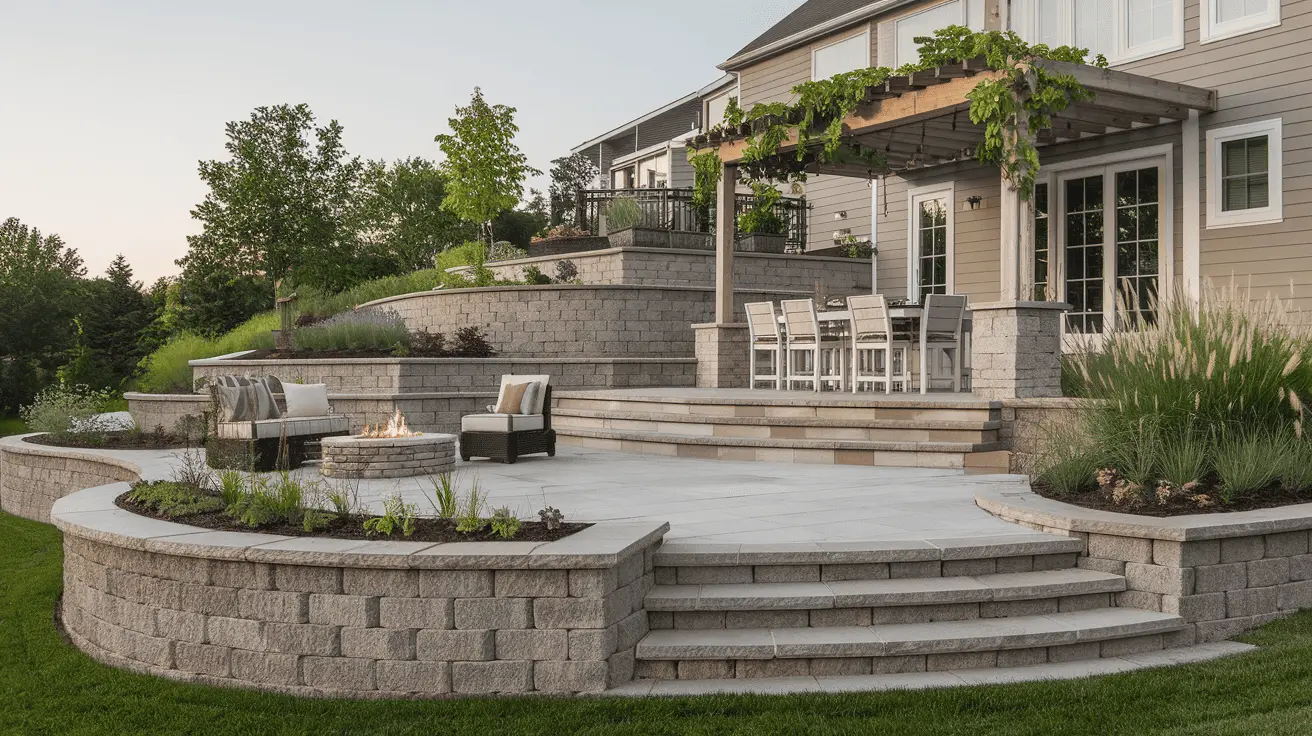
I know firsthand how frustrating a sloping backyard can be. My name is Pauline, and as a mom to two energetic kids who love playing outside, I struggled with our steep yard for years. Every time they tried to kick a ball around, it would roll straight downhill—and retrieving it from the neighbor’s yard wasn’t exactly their idea of fun. The uneven ground made it tough for them to run and play safely, and honestly, I wasn’t sure how to make the space work for our family.
But here’s the thing—those slopes? They’re not a problem. They’re an opportunity. We decided to embrace our steep backyard and turn it into a space that worked for us. By creating different flat sections, we gave the kids a level area for their games, and we even managed to carve out a cozy patio where we can sit and enjoy the outdoors. Now, I love spending time outside, and so do the kids. We even get visits from robins, which makes the space feel even more magical.
If you’ve been struggling with an uneven yard like I did, don’t worry—there are so many ways to make it beautiful and functional. Whether you want a tiered garden, a gravel patio, or retaining walls to create structure, there’s a solution that can transform your outdoor space into something truly special.
Create a Terraced Garden for a Beautiful and Functional Space
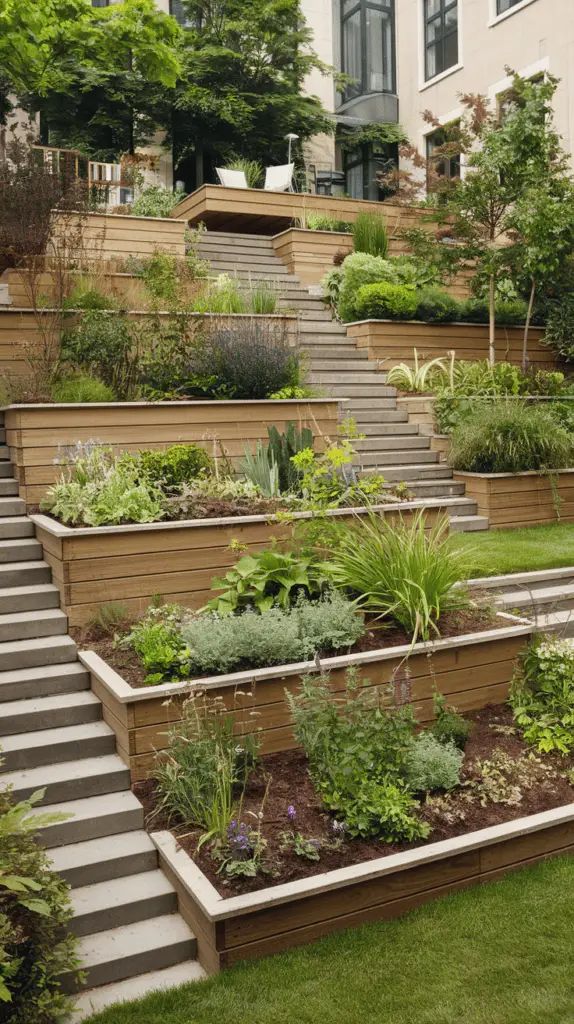
Terraced gardens are one of the most effective and visually appealing ways to make a steep backyard work for you. By carving the slope into a series of steps or levels, you create flat areas for planting, seating, or play spaces. This method not only makes your backyard easier to navigate but also helps with soil erosion by preventing water from rushing straight downhill.
The beauty of a terraced garden is its versatility. You can go for a structured, modern look with clean lines and uniform retaining walls, or embrace a more natural feel by using stacked stone or wooden sleepers. Boxwood landscaping can add a touch of classic elegance, framing each level with neatly trimmed greenery. If you want a softer, more inviting look, consider using river rock landscaping between terraces to create natural drainage pathways while adding texture and charm.
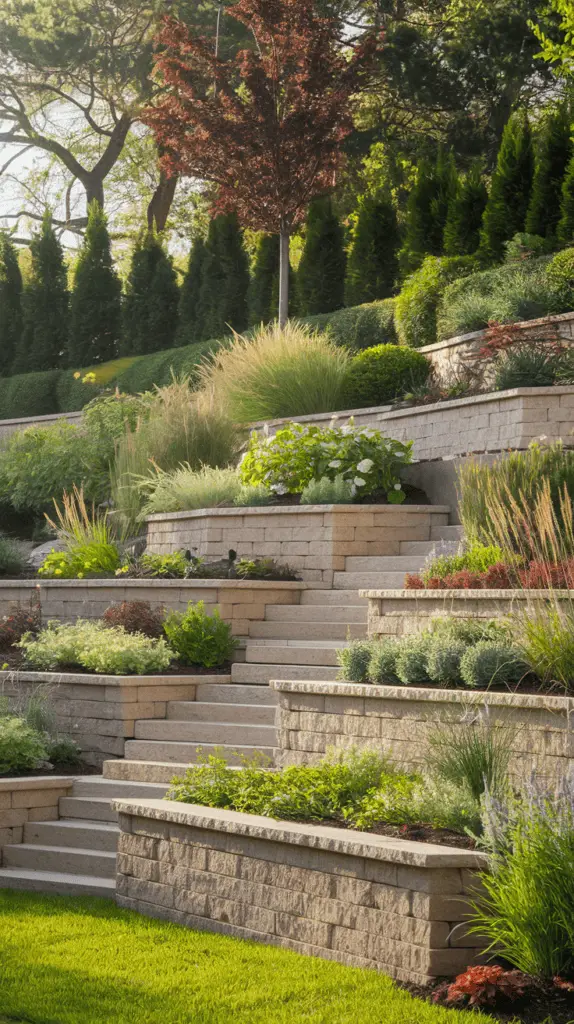
To enhance the usability of your space, think about what each level will be used for. The top level might house a cozy pea gravel patio with outdoor furniture, while the next tier down could be a vegetable garden or flower beds bursting with color. Lower levels can feature grass for the kids to play on or a quiet seating area surrounded by shade-loving plants. The key is to create a layout that feels cohesive and encourages movement throughout the space.
Design a Pea Gravel Patio for an Easy and Stylish Outdoor Area
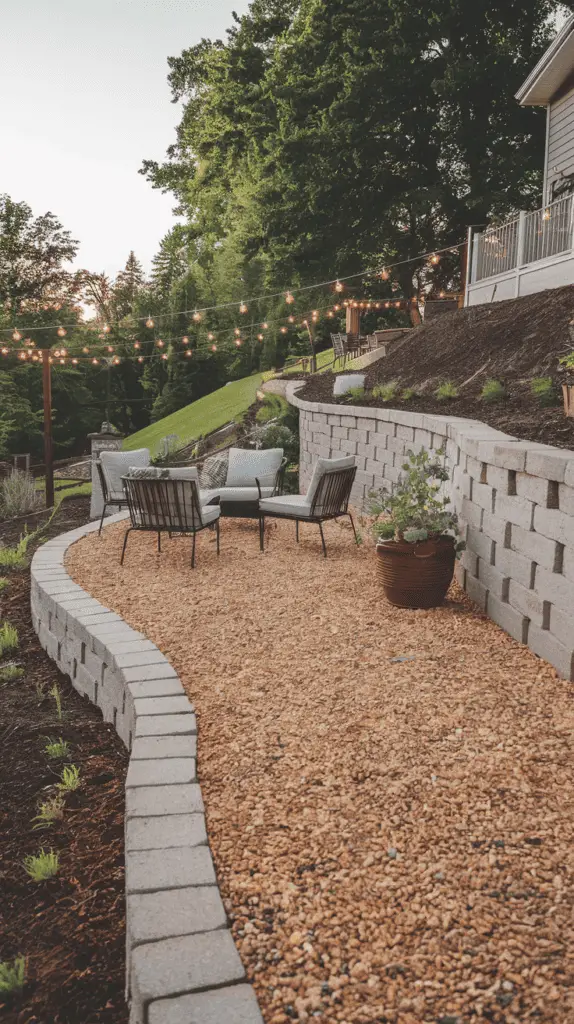
If you love the idea of a low-maintenance yet stylish outdoor retreat, a pea gravel patio could be the perfect solution. It’s affordable, easy to install, and blends beautifully with natural surroundings. Even better, it’s an excellent choice for sloped yards because it allows water to drain easily, preventing pooling and erosion.
Creating a pea gravel patio on a hill requires a bit of planning. First, you’ll need to carve out a level area by building a retaining wall or using tiered garden ideas to create a stable surface. Once the area is prepped, lay down landscape fabric to prevent weeds and spread a thick layer of pea gravel. Adding large stepping stones can help define the space and make it more comfortable to walk on.
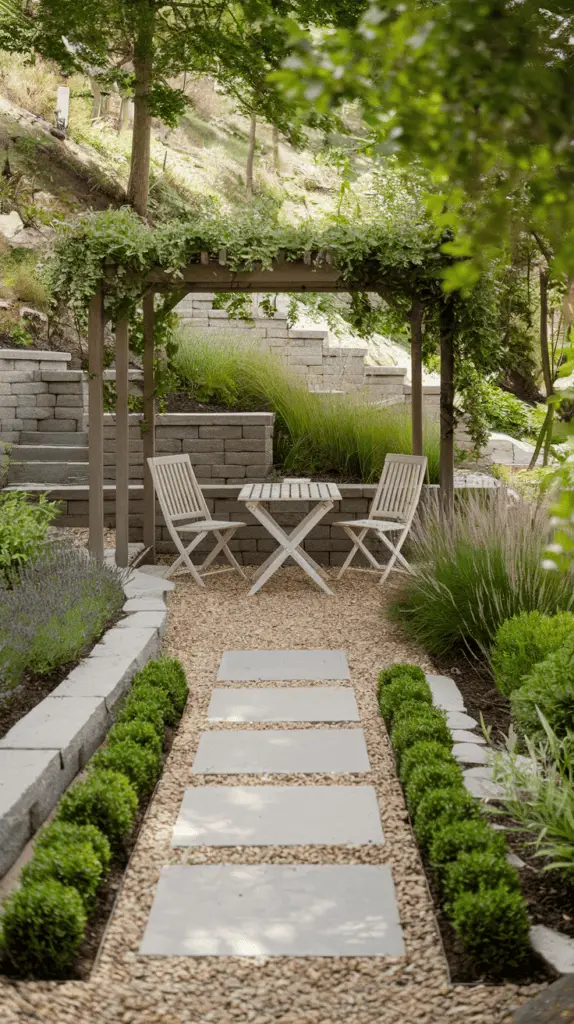
To make your patio feel like a true extension of your home, add cozy outdoor furniture, potted plants, and string lights for ambiance. If you want a little more structure, consider surrounding the space with low retaining walls made of stacked stone or timber. This not only adds definition to your patio but also provides built-in seating, making the space even more functional.
Install a Retaining Wall to Carve Out Usable Space

Landscaping on a hill often means dealing with erosion, runoff, and tricky slopes that don’t seem to serve any real purpose. One of the best ways to reclaim a steep yard is by installing a retaining wall to create a level area for gardening, seating, or even a small play area for kids.
Retaining walls can be built from a variety of materials, including stone, brick, timber, or concrete blocks, depending on the look you’re going for. A two-level retaining wall can be especially useful in larger backyards, helping to break up the space while adding depth and dimension. If you’re after a modern aesthetic, opt for clean, sleek materials like poured concrete or smooth stone. For a more rustic feel, weathered wood or natural rock can give your backyard a charming, organic look.
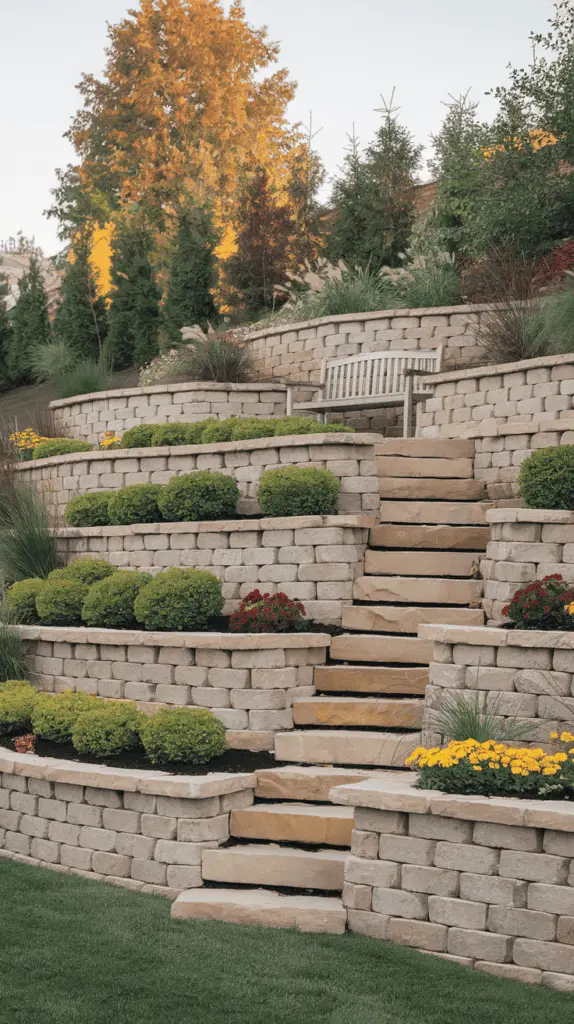
Beyond aesthetics, retaining walls play a crucial role in preventing soil erosion and managing water runoff. Adding drainage solutions like gravel backfill or perforated pipes behind the wall will help keep the structure stable and prevent water from collecting where you don’t want it.
Use River Rock Landscaping to Enhance Natural Beauty and Drainage
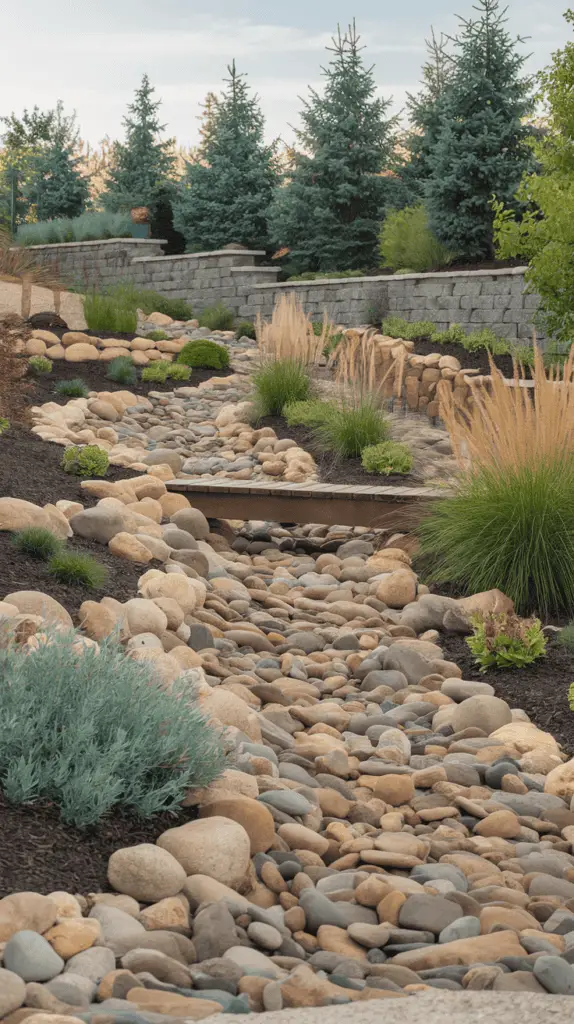
If you want a landscaping solution that’s both practical and visually stunning, river rock landscaping is an excellent choice for a sloped backyard. These smooth, rounded stones not only add texture and contrast to your garden but also help with drainage, preventing water from pooling in unwanted areas.
One of the simplest ways to incorporate river rocks is by creating a dry creek bed that runs down the slope, mimicking the natural flow of water. This not only looks beautiful but also directs rainwater away from structures and planting areas, reducing erosion. To make it feel even more natural, mix in a variety of rock sizes and add drought-tolerant plants like ornamental grasses or succulents along the edges.
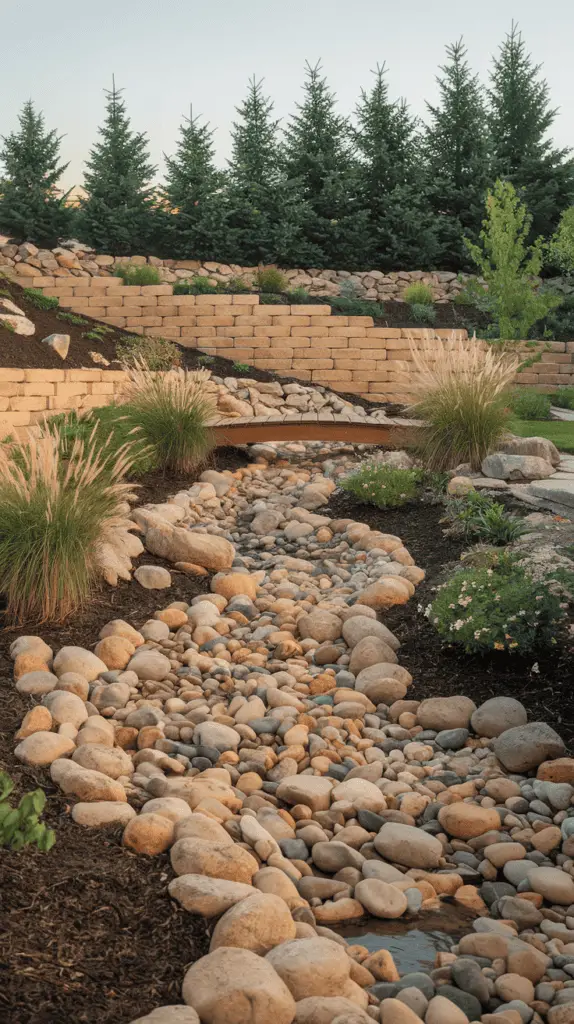
River rock can also be used to define garden beds, line pathways, or fill gaps between stepping stones in a sloped yard. If you have a steep incline, consider layering rocks in different sections to create a cascading effect, making the slope feel intentional rather than a challenge to work around.
Build a Tiered Garden to Maximize Planting Space
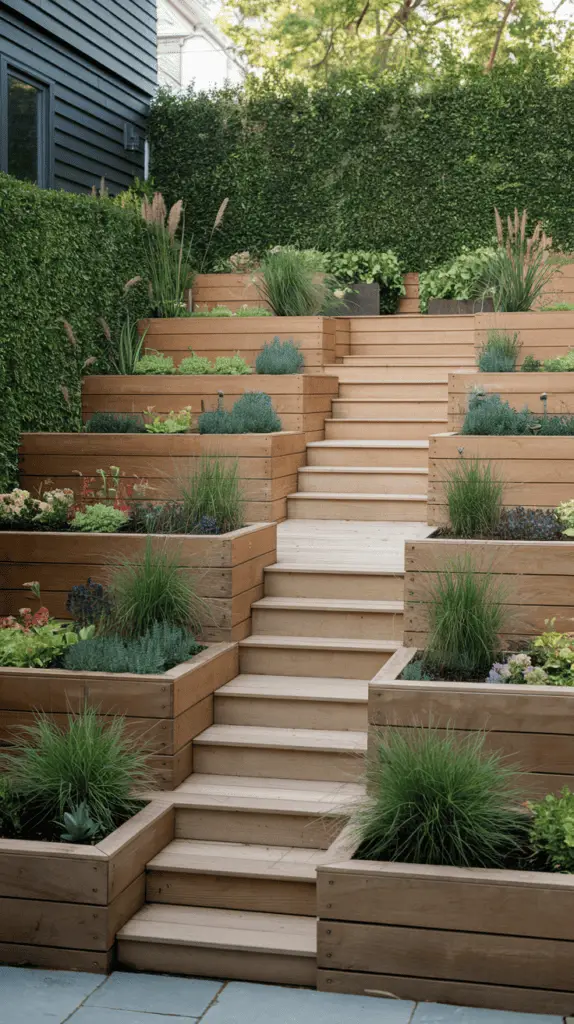
A tiered garden is a fantastic way to turn an uneven backyard into a lush, layered masterpiece. By creating different levels, you can take advantage of vertical space while making planting and maintenance easier. This approach works particularly well for small hill garden ideas, as it allows you to incorporate a variety of plants without them competing for space.
Start by defining each tier with retaining walls, wooden planters, or natural stone edging. The top tier can feature sun-loving plants, while the lower levels provide shade for more delicate varieties. If you love growing your own food, you can dedicate one level to a vegetable garden, using raised beds to make planting and harvesting more convenient.
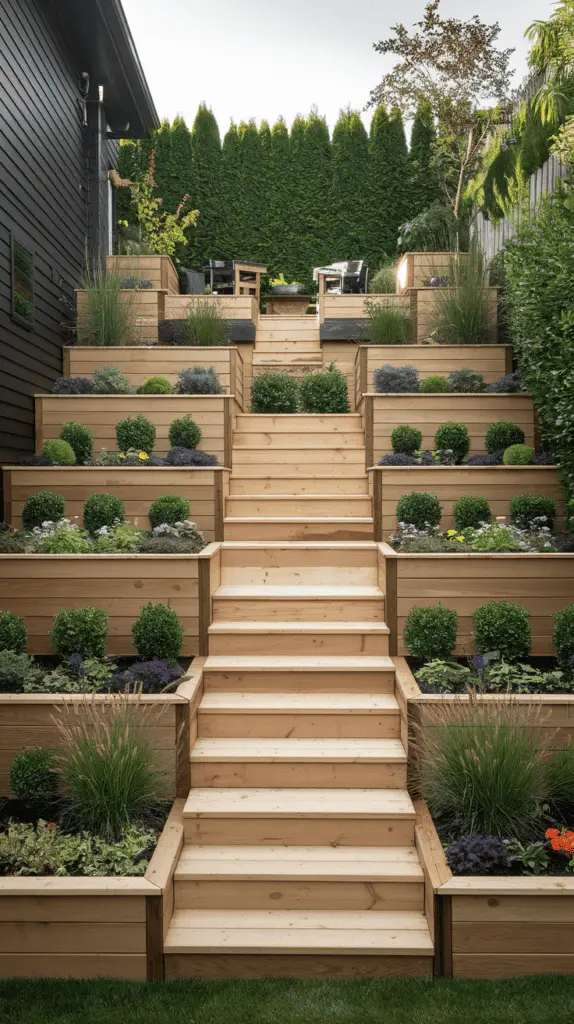
Adding pathways between tiers helps with accessibility and encourages movement through the garden. Gravel paths, wooden steps, or flagstone walkways can tie the different levels together while enhancing the overall design. If you want to make the space even more inviting, include seating areas or small water features to create a peaceful retreat.
Incorporate Boxwood Landscaping for a Classic and Elegant Look
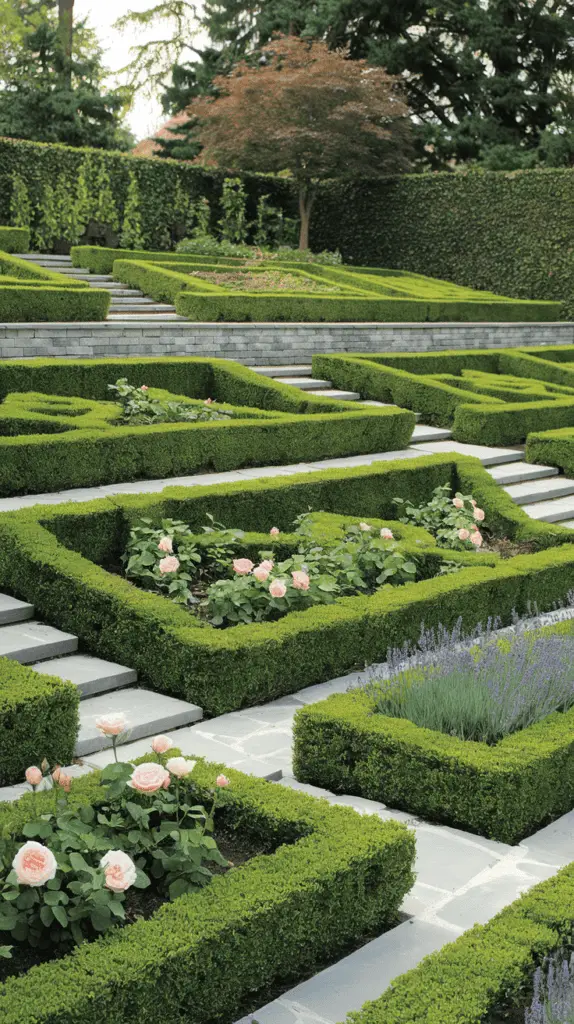
Boxwood landscaping is a timeless way to add structure and elegance to a sloped yard. These evergreen shrubs are perfect for defining different levels of your garden, creating neat borders, and softening the look of retaining walls. Whether you want a formal garden or a more relaxed, natural style, boxwoods can be shaped and arranged to suit your aesthetic.
One of the best ways to use boxwoods on a slope is by planting them along terraces to create a structured, layered effect. Their dense foliage makes them an excellent choice for erosion control, helping to stabilize the soil while providing year-round greenery. If you’re working with a steep backyard, consider mixing boxwoods with other low-maintenance plants like lavender, ornamental grasses, or creeping ground covers to add contrast and texture.
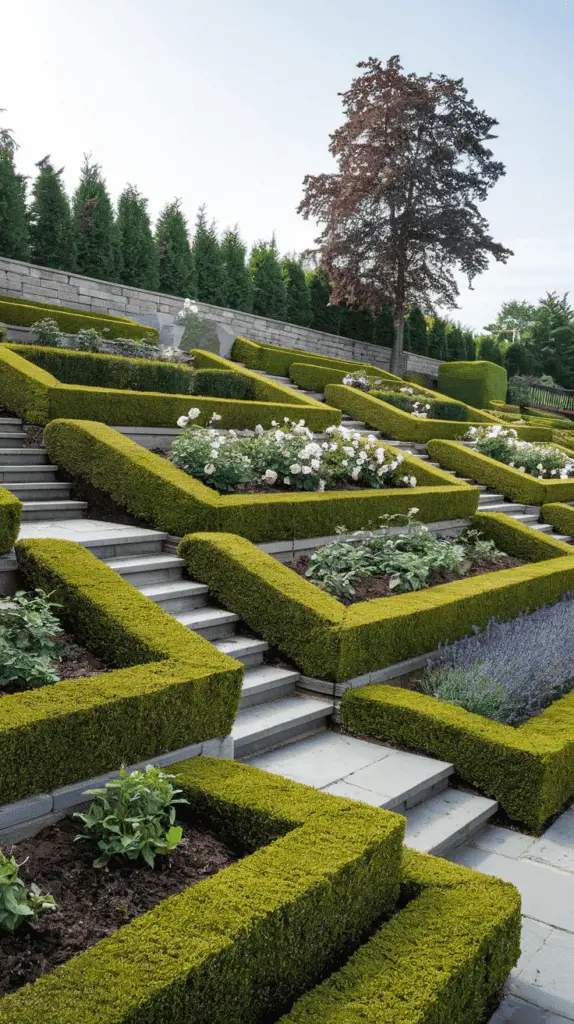
Boxwoods can also frame pathways, guide visitors through tiered gardens, or act as a lush backdrop for colorful flowers. For a more sculpted look, trim them into geometric shapes, or if you prefer a softer, more natural feel, let them grow slightly wild. Paired with stone walls, gravel paths, or wooden steps, boxwood landscaping can transform a steep backyard into a refined, inviting retreat.
Create a Raised Level Garden for Added Depth and Dimension

If your backyard slope isn’t too extreme, a raised level garden could be the perfect solution to break up the incline while adding visual interest. This approach allows you to create distinct planting areas or functional spaces, making even the trickiest landscapes feel intentional and well-designed.
To achieve this look, use tiered retaining walls or built-up garden beds to establish different levels. You can create a layered effect with planters, raised flower beds, or even seating areas integrated into the design. A raised garden bed along the slope can be an excellent way to grow herbs, vegetables, or flowers without worrying about soil erosion or water runoff.
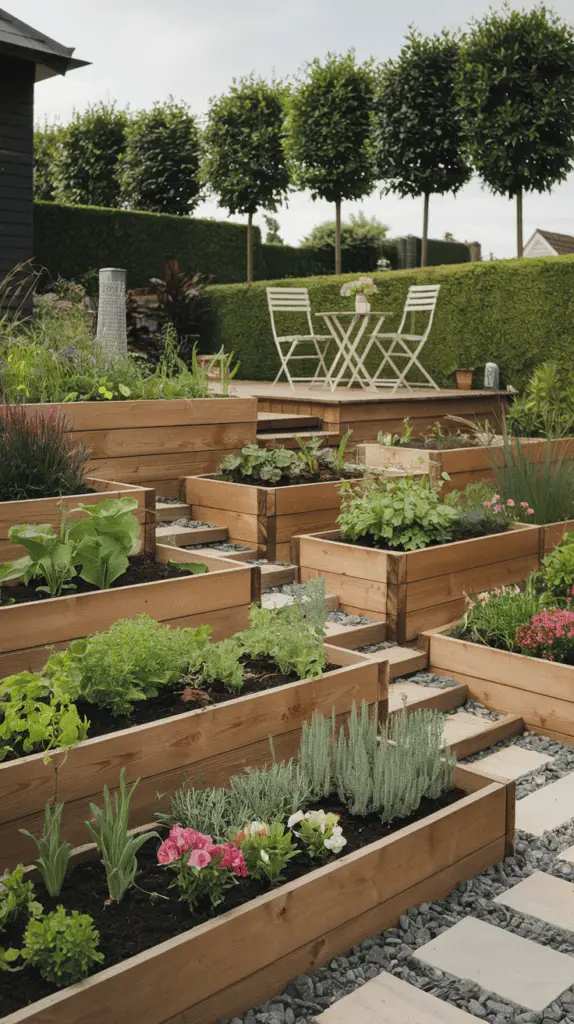
Another way to add depth is by using different materials for each level. A wooden deck at the top, a gravel pathway in the middle, and a lush lawn or patio space below can create a dynamic and visually engaging outdoor space. If you’re working with a small hill, stacking stone walls or wooden sleepers can define the levels while maintaining a natural, harmonious feel.
To make the most of a raised level garden, consider incorporating lighting to highlight the different layers at night. Small solar-powered lights along pathways or recessed lighting in retaining walls can create a cozy ambiance while making your garden safer to navigate after dark.
Install a Tiered Patio with Retaining Walls for a Multi-Level Entertainment Space
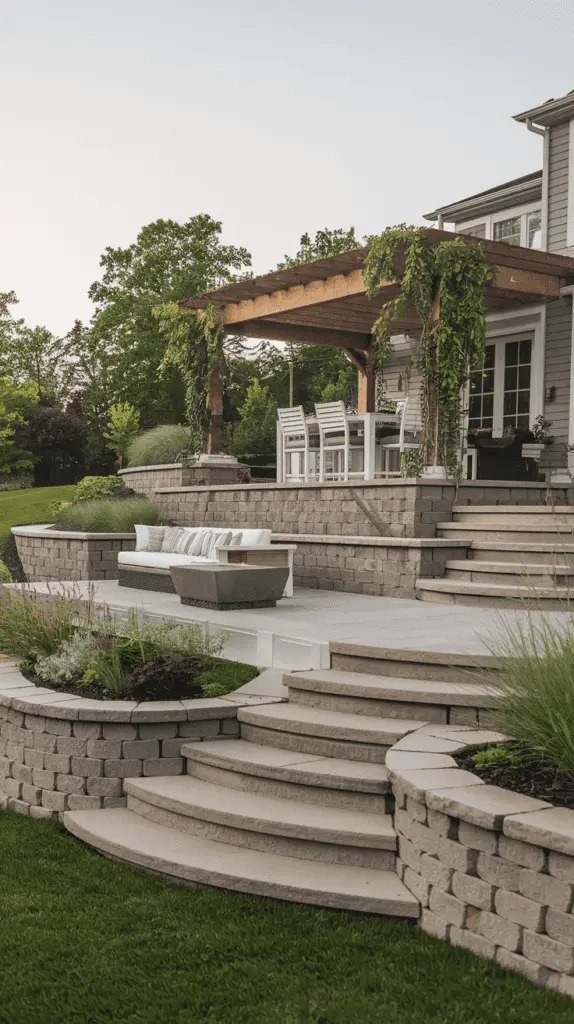
A tiered patio is an excellent way to maximize outdoor living space on a sloped backyard. By creating different levels, you can designate areas for dining, lounging, and even play, making your backyard more functional and enjoyable.
Start by dividing your slope into manageable sections, using retaining walls to carve out flat surfaces for each level. For a modern look, opt for clean-lined concrete or stone walls, while a more rustic feel can be achieved with natural stone or wooden sleepers. If you want a seamless transition between levels, integrate wide steps or gradual slopes into the design.
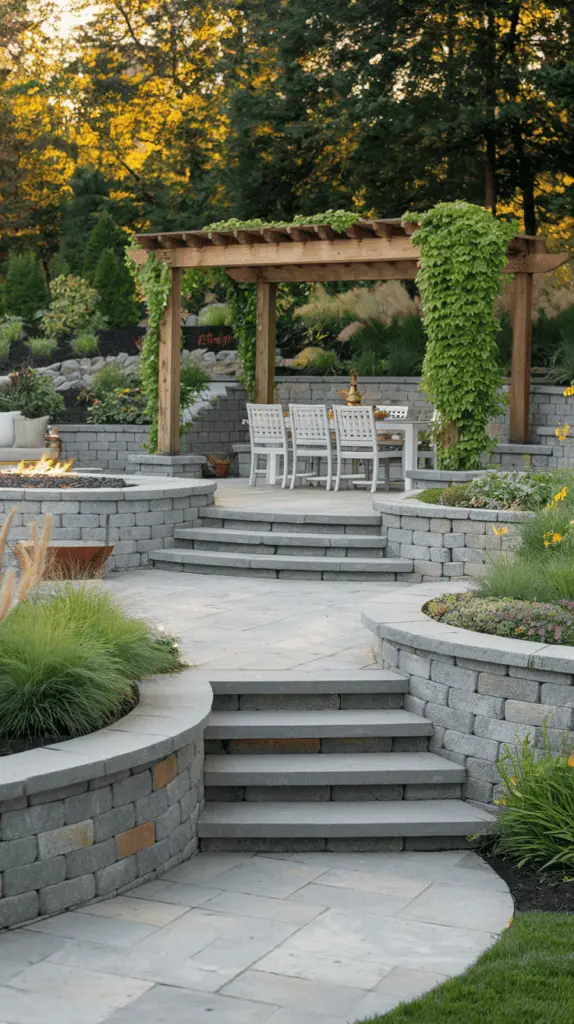
The key to a great tiered patio is ensuring each level has a distinct purpose. The top tier could serve as a dining area with a pergola or umbrella for shade, while the middle level might feature a cozy fire pit surrounded by comfortable seating. The lowest level can be a kid-friendly play area, a grassy lawn, or even a small water feature for added tranquility.
To enhance the space, consider using different flooring materials for each tier. A combination of pea gravel, flagstone, and wooden decking can add variety while maintaining a cohesive look. Adding potted plants, outdoor lighting, and decorative elements like built-in benches or a small fountain can elevate the design and make the space truly inviting.
Transform a Sloped Yard with Gravel Garden Paths and Steps

If your backyard slope makes walking or gardening a challenge, creating gravel paths and steps can be a practical and aesthetically pleasing solution. Gravel is an affordable, low-maintenance material that blends seamlessly with natural landscapes, making it ideal for sloped gardens.
Start by planning the route of your paths—do you want a meandering walkway that winds through flower beds, or a more structured staircase leading from one level to another? Using materials like stone, wood, or brick to border the paths will help contain the gravel and prevent it from shifting. Pea gravel is a great choice for pathways, as it’s small, comfortable to walk on, and allows water to drain easily, reducing erosion.
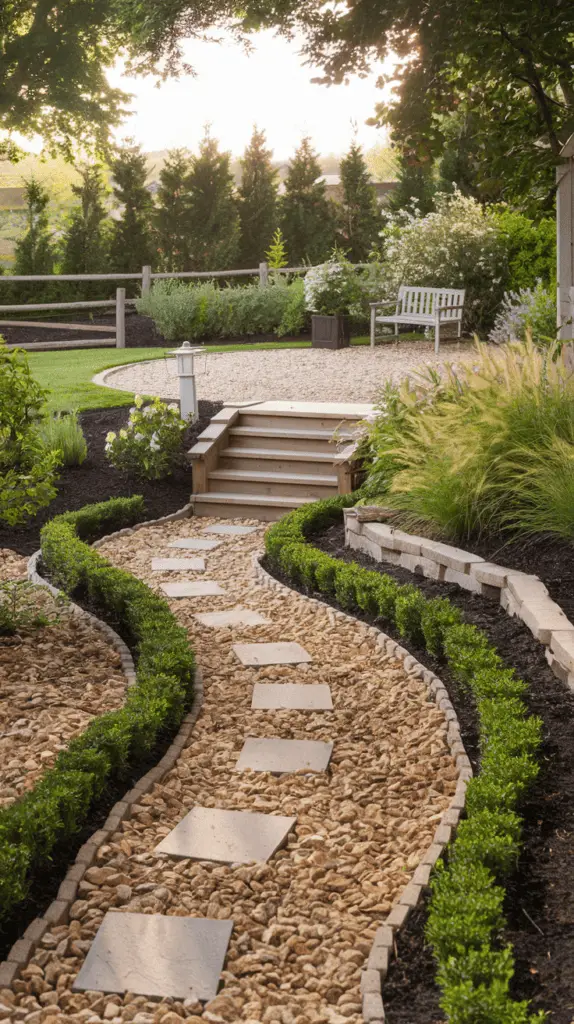
For added stability, consider incorporating larger stepping stones within the gravel or building wooden steps to break up steeper inclines. If you’re dealing with a significant slope, terraced landscaping with integrated pathways can make your garden more accessible while adding visual interest.
To make your paths more inviting, line them with plants like lavender, rosemary, or ornamental grasses, which will soften the edges and add fragrance as you walk through the garden. Outdoor lighting, such as solar-powered lanterns or embedded LED lights, can further enhance the beauty and functionality of your pathways, making your sloped backyard feel like a well-thought-out retreat.
Use Two-Level Retaining Walls for a Striking and Practical Landscape
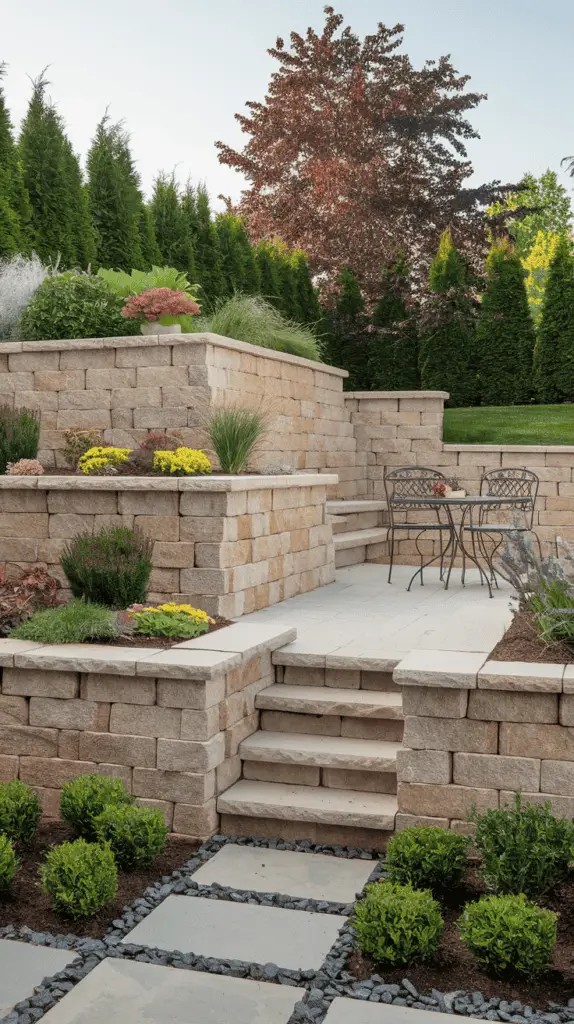
For backyards with a dramatic slope, two-level retaining walls can be a game-changer. This approach not only stabilizes the landscape but also creates visually striking tiers that can be used for planting, seating, or entertainment spaces.
A well-designed two-level retaining wall can transform a steep hill into a structured, multi-use garden. The upper level can feature a lush green space with flower beds or shrubs, while the lower level might serve as a patio, a children’s play area, or even a water feature. Using contrasting materials for each level—such as natural stone on the lower wall and timber on the upper—can add depth and interest to the design.
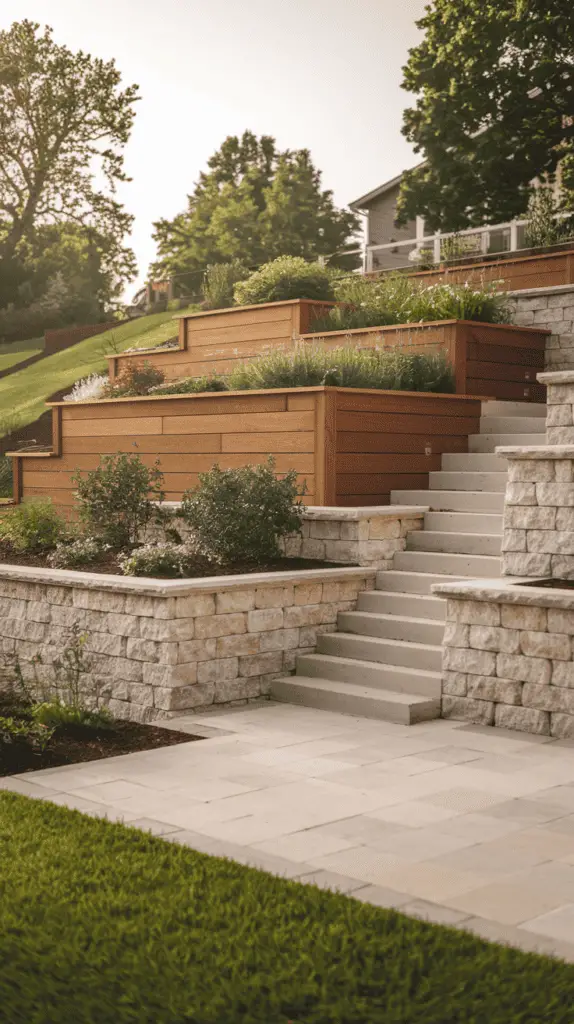
One of the biggest benefits of two-level retaining walls is the opportunity for built-in seating. By incorporating wide, flat surfaces at the edge of each level, you can create benches or lounging areas without taking up extra space. Adding integrated lighting within the walls can enhance the ambiance, making the area feel warm and inviting after sunset.
To prevent drainage issues, be sure to install proper water management systems, such as perforated pipes or gravel backfill, behind the walls. This will ensure the stability of the structure and prevent water from pooling in unwanted areas.
Final Thoughts
A sloped backyard doesn’t have to be a frustrating, wasted space—it can be a canvas for creativity, function, and beauty. Whether you choose to carve out terraces, build a tiered patio, or use gravel paths to navigate the incline, there are countless ways to make a steep landscape work in your favor.
The key is to embrace the natural contours of your yard rather than fighting against them. With a little strategic planning, the right materials, and a touch of inspiration, your sloped backyard can become a stunning outdoor sanctuary. So next time you look at that tricky incline, don’t see a problem—see a world of possibilities waiting to unfold.
